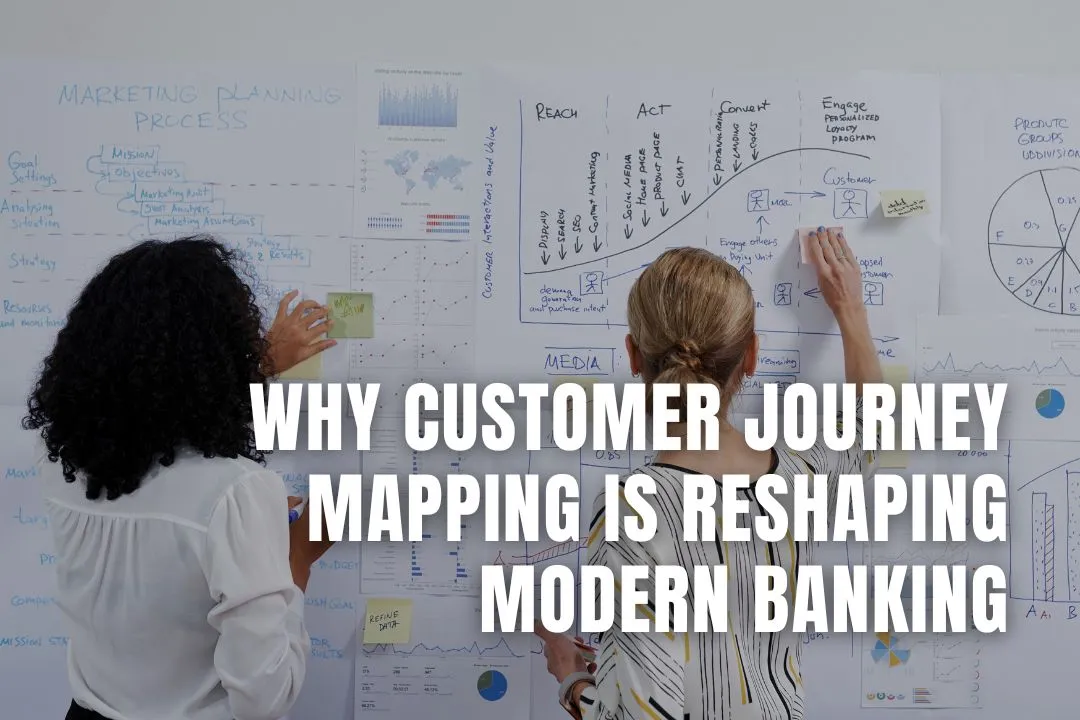Why Customer Journey Mapping Is Reshaping Modern Banking
July 18, 2025

Banks are not just vaults and numbers anymore. They are experiences. And the way people interact with those experiences is shifting fast. Customers expect more than smooth transactions. They want seamless digital flows, meaningful communication, and a sense that their bank understands them on a deeper level.
That is where customer journey mapping comes in. It is not a new concept, but its influence on modern banking is growing fast, and for good reason. As banking becomes more digital and less face-to-face, understanding the full customer experience is no longer optional. It is essential.
Key Takeaways on Customer Journey Mapping in Modern Banking
- What is CJM in Banking?: Customer Journey Mapping visualises every customer interaction with a bank, detailing their thoughts, feelings, and goals at each step to identify pain points and value delivery.
- Shift Towards Personalisation: CJM helps banks understand specific customer needs at different life stages, enabling the creation of more relevant and personalised services.
- Closing Channel Gaps: It reveals inconsistencies between digital, phone, and in-person banking channels, allowing banks to design smoother transitions and build customer trust.
- Human-Centred Digital Transformation: CJM ensures digital transformation efforts are rooted in real customer behaviours and needs, preventing wasted investment and focusing on impactful solutions.
- Better Employee Alignment: By providing a shared view of the customer experience, CJM helps internal teams align their efforts towards common goals, improving overall service delivery.
- Turning Insights Into Action: The true value of CJM lies in implementing changes based on its insights, such as streamlining onboarding, improving support handovers, or adding proactive customer touchpoints.
- Impactful Stages: CJM yields the biggest gains when applied to high-stakes moments like account opening, problem resolution, loan applications, digital onboarding, and significant life events.
- Defining Success: Success in CJM is achieved by removing obstacles, simplifying processes, and ensuring clear communication, leading to increased customer engagement, loyalty, and stronger relationships.
- Mindset Shift: CJM is more than a tool, it's a shift in mindset that encourages banks to focus on people and their real needs, designing experiences that feel seamless and intuitive.
Register Your LLC
Company Registration
START NOWWhat Is Customer Journey Mapping in Banking?
Customer journey mapping is the process of visualising every step a customer takes when interacting with a bank. That includes everything from browsing mortgage options online to calling customer service, visiting a branch, or setting up mobile alerts.
But it is not just a timeline of events. A good journey map digs into what customers are feeling, thinking, and trying to achieve at each step. It highlights pain points, uncovers gaps, and pinpoints where the bank is delivering value — and where it is falling short.
This approach gives banks a full-picture view of the customer experience across all touchpoints, not just isolated moments.
Why It Matters More Than Ever
Banking is no longer driven by products. It is driven by experiences. Customers expect their bank to know them, to anticipate their needs, and to remove friction from their day-to-day interactions.
Without a clear understanding of the journey customers take, banks are flying blind. They might improve one part of the process while neglecting others that cause more damage to loyalty and trust. Journey mapping brings clarity. It helps teams see things from the customer’s perspective and spot the disconnects that internal teams often miss.
Here is why it is becoming such a powerful tool in modern banking.
A Shift Towards Personalisation
People want personalised experiences. That does not just mean getting their name right in an email. It means recognising their goals, life events, and habits — and responding to them in meaningful ways.
Journey mapping helps banks identify what customers truly need at each stage. For example, someone exploring first-time home loans will have very different priorities compared to someone seeking investment advice. The journey map shows where these needs emerge, what questions customers have, and how the bank can support them more effectively.
Done well, this leads to services that feel less generic and more relevant. It shows the bank is paying attention.
Closing the Gaps Between Channels
One of the biggest frustrations in banking today is inconsistency between channels. A customer starts something online, then has to repeat everything in a branch. They call support and have to explain the issue again. This lack of continuity is a major source of friction.
Journey mapping uncovers where these breakdowns happen. It identifies when customers are forced to switch channels and how that affects their perception of the bank. More importantly, it allows banks to redesign those transitions to be smoother and less disruptive.
Consistency across digital, phone, and in-person experiences builds trust. When customers see that the bank knows who they are and what they have already done, they are more likely to stay loyal.
A More Human Approach to Digital Transformation
There is a lot of talk about digital transformation in banking, but many efforts still fall short because they do not start with the customer. Banks invest in new systems, redesign apps, or automate services — but if they do not solve the right problems, none of it sticks.
Customer journey mapping flips the focus. It asks, “What do our customers actually need to achieve here?” and then works backwards. This creates a more human-centred transformation. One that is rooted in real behaviours, not just business goals.
It also prevents wasted investment. Banks can focus their resources on the moments that matter most, rather than guessing or relying on internal assumptions.
Better Employee Alignment
Internal teams often work in silos. One team handles digital, another focuses on branches, another on customer service. But the customer experience crosses all of those boundaries.
Journey mapping brings everyone onto the same page. It creates a shared understanding of how the customer sees the bank, where improvements are needed, and what good service looks like.
When teams have that visibility, it is easier to align around common goals. They stop thinking in terms of channels and start thinking in terms of experiences.
Turning Insights Into Action
The real power of customer journey mapping lies in what comes next. It is not enough to create a nice diagram and move on. The insights must lead to real, visible changes.
That could mean:
- Redesigning onboarding – Making it easier for new customers to set up accounts without delays or confusion.
- Fixing support handovers – Ensuring that if a customer moves from chat to phone, they do not have to repeat everything.
- Adding proactive touchpoints – Reaching out at key life stages, such as preparing for retirement or buying a home.
- Simplifying common tasks – Streamlining actions like transferring funds or updating personal details across channels.
These actions are what turn a map into progress. They make the customer feel seen and valued, not just processed.
Key Stages Where Mapping Has the Biggest Impact
Some parts of the customer journey are more emotionally loaded than others. These stages are where mapping tends to drive the biggest gains.
Here are the key moments to focus on:
- Account opening – If this process is slow or confusing, customers may abandon it before completion.
- Problem resolution – When things go wrong, the way a bank responds can make or break trust.
- Loan or mortgage applications – These are often complex and stressful, so reducing friction here matters a lot.
- Digital onboarding – Getting customers up to speed with mobile or online services needs to feel intuitive.
- Life events – Marriage, moving home, changing jobs. These moments are rich opportunities for tailored support.
By zooming in on these high-stakes stages, banks can make changes that customers truly feel.
What Success Looks Like
It is not always about adding more features or faster tech. Often, success comes from removing obstacles. A well-mapped customer journey will highlight the small moments where frustration builds and identify where effort outweighs reward.
Improvements might include fewer steps, clearer messages, or better timing. When the journey flows naturally, customers stay engaged. They feel understood. And that leads to stronger loyalty and better relationships.
Rethinking the Role of Customer Experience
Customer journey mapping is not just a design tool. It is a mindset shift. It encourages banks to stop thinking about processes and start thinking about people.
The best banking experiences feel invisible. They just work. But getting to that point takes intention. It means stepping back, observing how customers actually behave, and designing around real needs, not assumptions.
As banking continues to evolve, the institutions that thrive will be the ones who understand their customers not just as account holders, but as people navigating complex lives.
A Smarter Way Forward
Customer expectations are only going in one direction. Higher. Banks that continue to guess at what people want will fall behind. But those that take the time to map out the real journey, step by step, will uncover opportunities that competitors miss.
It is not about flashy features. It is about clarity, empathy, and follow-through. When the experience is built around the customer, everything else starts to make sense.
That is what will reshape modern banking, and the shift is already underway.

